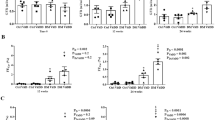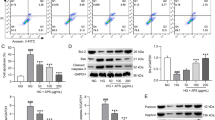Abstract
In diabetic nephropathy (DN), intercellular communication is disrupted. Connexins (Cx) have a crucial role in that process. Dietary ratios and supplementation with polyunsaturated fatty acids (PUFAs) can alleviate diabetic complications and cause alterations in Cx levels. Although pannexins (Panx) share similarities with members of the Cx family, their function in diabetic nephropathy has still not been fully determined. We studied the influence of PUFA supplementation on the immunoexpression of Px1 and Cx family members in diabetic kidneys of rats. Four groups of rats in experimental DM1 model were supplemented with different dietary n-6/n-3 ratios; ≈7 in control (C) and diabetic groups (STZ), ≈ 60 in the STZ + N6 group and ≈ 1 (containing 16% EPA and 19% DHA) in the STZ + N3 group. Immunoexpression of Cx40, Cx43, Cx45 and Panx1 was evaluated in the renal tissue of diabetic rats using immunohistochemistry. Diabetes significantly decreased the protein expression of Cx40 and Cx43 and increased Panx1 protein expression in the renal cortex (p < 0.05–p < 0.01). There was a significant impact of diet on Cx and Panx1 immunoexpression. Dietary supplementation with a high n-6/n-3 ratio downregulated the protein expression of Cx45 and Panx1 in diabetic rats (p < 0.05–p < 0.01), while Cx43 immunoexpression was increased in diabetic rats fed with high and low n-6/n-3 ratios (p < 0.01–p < 0.001). Hyperglycaemic conditions in DN interfere with cell-to-cell communication and disturb the connection between cells and their immediate environment due to variations in connexin and pannexin immunoexpression. These variations can be regulated by PUFA dietary intake, suggesting their beneficial effect and possible therapeutic option.





Similar content being viewed by others
References
Abed AB, Kavvadas P, Chadjichristos CE (2015) Functional roles of connexins and pannexins in the kidney. Cell Mol Life Sci. 72:2869–2877
Adamson SE, Meher AK, Chiu Y-H, Sandilos JK, Oberholtzer NP, Walker NN et al (2015) Pannexin 1 is required for full activation of insulin-stimulated glucose uptake in adipocytes. Mol Metab. 4:610–618
Champeil-Potokar G, Chaumontet C, Guesnet P, Lavialle M, Denis I (2006) Docosahexaenoic acid (22:6n–3) enrichment of membrane phospholipids increases gap junction coupling capacity in cultured astrocytes. Eur J Neurosci. 24:3084–3090
Chiu Y-H, Schappe MS, Desai BN, Bayliss DA (2018) Revisiting multimodal activation and channel properties of pannexin 1. J Gen Physiol. 150:19–39
Chung H-F, Long KZ, Hsu C-C, Al Mamun A, Jhang H-R, Shin S-J et al (2015) Association of n-3 polyunsaturated fatty acids and inflammatory indicators with renal function decline in type 2 diabetes. Clin Nutr. 34:229–234
Cottrell GT, Burt JM (2005) Functional consequences of heterogeneous gap junction channel formation and its influence in health and disease. Biochim Biophys Acta Biomembr. 1711:126–1241
Cottrell GT, Wu Y, Burt JM (2002) Cx40 and Cx43 expression ratio influences heteromeric/heterotypic gap junction channel properties. Am J Physiol Cell Physiol. 282:C1469–C1482
Cui H, Liu Y, Qin L, Wang L, Huang Y (2016) Increased membrane localization of pannexin1 in human corneal synaptosomes causes enhanced stimulated ATP release in chronic diabetes mellitus. Medicine (Baltimore). 95:e5084
Delic Jukic IK, Kostic S, Filipovic N, Gudelj Ensor L, Ivandic M, Dukic JJ et al (2018) Changes in expression of special AT-rich sequence binding protein 1 and phosphatase and tensin homologue in kidneys of diabetic rats during ageing. Nephrol Dial Transplant. 33:1734–1741
Dlugosova K, Okruhlicova L, Mitasikova M, Sotnikova R, Bernátová I, Weismann P et al (2009) Modulation of connexin-43 by omega-3 fatty acids in the aorta of old spontaneously hypertensive rats. J Physiol Pharmacol. 60:63–69
Evert AB, Boucher JL, Cypress M, Dunbar SA, Franz MJ, Mayer-Davis EJ et al (2014) Nutrition therapy recommendations for the management of adults with diabetes. Diabetes Care 37(Supplement 1):S120–S143
Hammer Ø, Harper DAT, Ryan PD (2001) PAST: Paleontological statistics software package for education and data analysis. Palaeontol Electron. 4:9
Hanner F, Sorensen CM, Holstein-Rathlou N-H, Peti-Peterdi J (2010) Connexins and the kidney. Am J Physiol Regul Integr Comp Physiol. 298:R1143–R1155
Hills CE, Bland R, Wheelans DC, Bennett J, Ronco PM, Squires PE (2006) Glucose-evoked alterations in connexin43-mediated cell-to-cell communication in human collecting duct: a possible role in diabetic nephropathy. Am J Physiol Regul Integr Comp Physiol. 291:F1045–F1051
Hills CE, Price GW, Wall MJ, Kaufmann TJ, Chi-wai Tang S, Yiu WH et al (2018) Transforming growth factor beta 1 drives a switch in connexin mediated cell-to-cell communication in tubular cells of the diabetic kidney. Cell Physiol Biochem 45:2369–2388
Kagohashi Y, Otani H (2010) Diet with a low n-6/n-3 essential fatty acid ratio when started immediately after the onset of overt diabetes prolongs survival of type 1 diabetes model NOD mice. Congenit Anom (Kioto). 50:226–231
Kavvadas P, Abed A, Poulain C, Authier F, Labéjof L-P, Calmont A et al (2017) Decreased expression of connexin 43 blunts the progression of experimental GN. J Am Soc Nephrol. 28:2915–2930
Kopál M, Ondrejovičová I, Deáková Z, Uličná O, Vančová O, Duračková Z et al (2014) Effect of PUFA-rich plant oil on risk factors of STZ-induced diabetes in Wistar rats. Redox Rep. 19:161–169
Langelier B, Linard A, Bordat C, Lavialle M, Heberden C (2010) Long chain-polyunsaturated fatty acids modulate membrane phospholipid composition and protein localization in lipid rafts of neural stem cell cultures. J Cell Biochem. 110:1356–1364
Liu H-Q, Qiu Y, Mu Y, Zhang X-J, Liu L, Hou X-H et al (2013) A high ratio of dietary n-3/n-6 polyunsaturated fatty acids improves obesity-linked inflammation and insulin resistance through suppressing activation of TLR4 in SD rats. Nutr Res 33:849–858
Liu Z, Liu Y, Zhou H, Fu X, Hu G (2017) Epoxyeicosatrienoic acid ameliorates cerebral ischemia-reperfusion injury by inhibiting inflammatory factors and pannexin-1. Mol Med Rep. 16:2179–2184
Prakoura N, Kavvadas P, Chadjichristos CE (2018) Connexin 43: a new therapeutic target against chronic kidney disease. Cell Physiol Biochem. 49:998–1009
Puebla C, Cisterna BA, Salas DP, Delgado-López F, Lampe PD, Sáez JC (2016) Linoleic acid permeabilizes gastric epithelial cells by increasing connexin 43 levels in the cell membrane via a GPR40- and Akt-dependent mechanism. Biochim Biophys Acta. 1861:439–448
Puebla C, Retamal MA, Acuña R, Sáez JC (2017) Regulation of connexin-based channels by fatty acids. Front Physiol. 8:11
Radosinska J, Lin H, Hiraishi K, Viczenczová C, Egan Benova T, Szeiff Bacova B et al (2015) Modulation of cardiac connexin-43 by omega-3 fatty acid ethyl-ester supplementation demonstrated in spontaneously diabetic rats. Physiol Res. 64:795–806
Samuels SE, Lipitz JB, Wang J, Dahl G, Muller KJ (2013) Arachidonic acid closes innexin/pannexin channels and thereby inhibits microglia cell movement to a nerve injury. Dev Neurobiol. 73:621–631
Sato T, Haimovici R, Kao R, Li A-F, Roy S (2002) Downregulation of connexin 43 expression by high glucose reduces gap junction activity in microvascular endothelial cells. Diabetes 51:1565–1571
Satriano J, Mansoury H, Deng A, Sharma K, Vallon V, Blantz RC et al (2010) Transition of kidney tubule cells to a senescent phenotype in early experimental diabetes. Am J Physiol Cell Physiol. 299:C374–C380
Sawai K, Mukoyama M, Mori K, Yokoi H, Koshikawa M, Yoshioka T et al (2006) Redistribution of connexin43 expression in glomerular podocytes predicts poor renal prognosis in patients with type 2 diabetes and overt nephropathy. Nephrol Dial Transplant. 21:2472–2477
Shapiro H, Theilla M, Attal-Singer J, Singer P (2010) Effects of polyunsaturated fatty acid consumption in diabetic nephropathy. Nat Rev Nephrol. 7:110
Simopoulos AP (2016) An increase in the omega-6/omega-3 fatty acid ratio increases the risk for obesity. Nutrients. 8:128
Starčević K, Filipović N, Galan A, Micek V, Gudan Kurilj A, Mašek T (2018) Hepatic lipogenesis and brain fatty acid profile in response to different dietary n6/n3 ratios and DHA/EPA supplementation in streptozotocin treated rats. Mol Nutr Food Res. 62:1701007
Takenaka T, Inoue T, Okada H, Ohno Y, Miyazaki T, Chaston DJ et al (2011) Altered gap junctional communication and renal haemodynamics in Zucker fatty rat model of type 2 diabetes. Diabetologia 54:2192–2201
Torres-Castillo N, Silva-Gómez JA, Campos-Perez W, Barron-Cabrera E, Hernandez-Cañaveral I, Garcia-Cazarin M et al (2018) High dietary ω-6:ω-3 PUFA ratio is positively associated with excessive adiposity and waist circumference. Obes Facts. 11:344–353
Vitlov Uljevic M, Starcevic K, Masek T, Bocina I, Restovic I, Kevic N et al (2019) Dietary DHA/EPA supplementation ameliorates diabetic nephropathy by protecting from distal tubular cell damage. Cell Tissue Res. 378:301–317
Willebrords J, Maes M, Crespo Yanguas S, Vinken M (2017) Inhibitors of connexin and pannexin channels as potential therapeutics. Pharmacol Ther. 180:144–160
Wright JA, Richards T, Becker DL (2012) Connexins and diabetes. Cardiol Res Pract. 2012:496904
Wu JHY, Marklund M, Imamura F, Tintle N, Ardisson Korat AV, de Goede J et al (2017) Omega-6 fatty acid biomarkers and incident type 2 diabetes: pooled analysis of individual-level data for 39 740 adults from 20 prospective cohort studies. Lancet Diabetes Endocrinol. 5:965–974
Yang LG, Song ZX, Yin H, Wang YY, Shu GF, Lu HX et al (2016) Low n-6/n-3 PUFA ratio improves lipid metabolism, inflammation, oxidative stress and endothelial function in rats using plant oils as n-3 fatty acid source. Lipids 51:49–59
Yeshao W, Gu J, Peng X, Nairn AC, Nadler JL (2005) Elevated glucose activates protein synthesis in cultured cardiac myocytes. Metabolism. 54:1453–1460
Yokoyama M, Tanigawa K, Murata T, Kobayashi Y, Tada E, Suzuki I et al (2010) Dietary polyunsaturated fatty acids slow the progression of diabetic nephropathy in streptozotocin-induced diabetic rats. Nutr Res. 30:217–225
Zeng O, Li F, Li Y, Li L, Xiao T, Chu C et al (2016) Effect of novel gasotransmitter hydrogen sulfide on renal fibrosis and connexins expression in diabetic rats. Bioengineered 7:314–320
Zhang X, Chen X, Wu D, Liu W, Wang J, Feng Z et al (2006) Downregulation of connexin 43 expression by high glucose induces senescence in glomerular mesangial cells. J Am Soc Nephrol. 17:1532
Zhukovska A, Shysh A, Bacova B, Radosinska J, Benova T, Viczenczova C et al (2014) Heart-protective effect of n-3 PUFA demonstrated in a rat model of diabetic cardiomyopathy. Mol Cell Biochem. 389:219–227
Acknowledgements
This work has been supported in part by the Croatian Science Foundation under the project (IP-2014-09-8992; T. Mašek) and by the Ministry of Science, Education and Sports of the Republic of Croatia support (K. Vukojević, N. Filipović). Authors thank Mirela Lozić for the language correction of the manuscript.
Author information
Authors and Affiliations
Corresponding author
Ethics declarations
Conflict of interest
All authors declare no conflict of interest.
Additional information
Publisher's Note
Springer Nature remains neutral with regard to jurisdictional claims in published maps and institutional affiliations.
Rights and permissions
About this article
Cite this article
Luetić, M., Vitlov Uljević, M., Mašek, T. et al. PUFAs supplementation affects the renal expression of pannexin 1 and connexins in diabetic kidney of rats. Histochem Cell Biol 153, 165–175 (2020). https://doi.org/10.1007/s00418-019-01838-9
Accepted:
Published:
Issue Date:
DOI: https://doi.org/10.1007/s00418-019-01838-9




